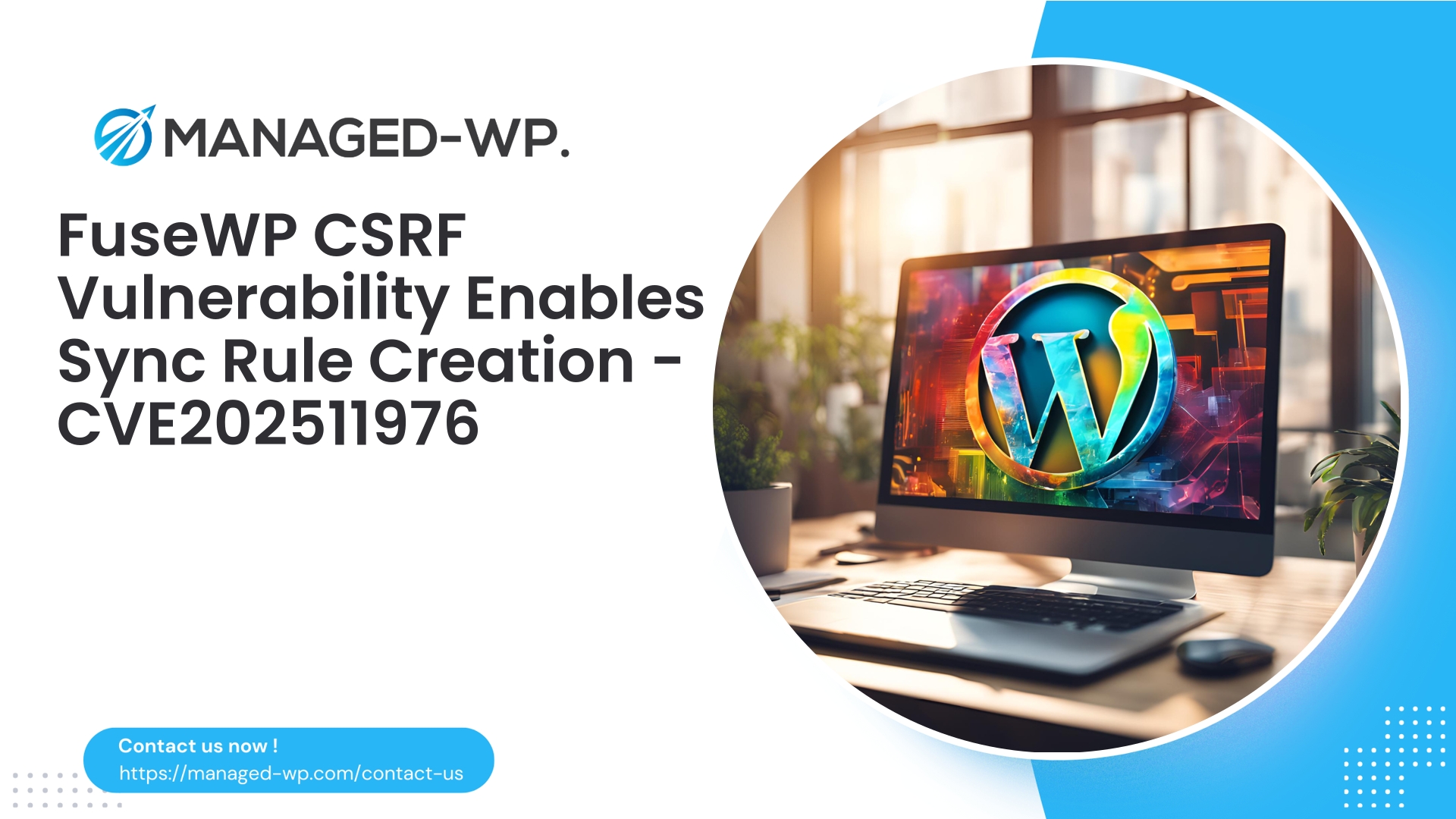| 插件名稱 | FuseWP – WordPress 使用者同步到電子郵件清單和行銷自動化 |
|---|---|
| 漏洞類型 | CSRF |
| CVE編號 | CVE-2025-11976 |
| 緊急 | 低的 |
| CVE 發布日期 | 2025-10-28 |
| 來源網址 | CVE-2025-11976 |
執行摘要
2025年10月28日,FuseWP – WordPress 使用者同步到電子郵件清單及行銷自動化外掛程式被報告存在跨站請求偽造 (CSRF) 漏洞 (CVE-2025-11976)。該外掛程式版本 1.1.23.0 及更早版本均受此漏洞影響,開發者已發布 1.1.23.1 版本修復此問題。
此漏洞使遠端攻擊者能夠誘騙具有特權的使用者(例如管理員或編輯)在不知情的情況下,在其已認證的 WordPress 會話中執行操作。具體而言,它允許在 FuseWP 中建立未經授權的“同步規則”,這些規則可被利用來將使用者資料傳輸到外部服務、更改自動化工作流程或以其他方式破壞資料完整性。
在本簡報中,Managed-WP 將詳細分析技術層面的問題,評估相關風險,並概述切實可行的補救方案。我們還將詳細介紹 Managed-WP 的安全服務如何提供即時保護,以及 WordPress 網站所有者必須採取的關鍵步驟。
用簡單易懂的語言理解漏洞
跨站請求偽造 (CSRF) 是指攻擊者欺騙已認證使用者的瀏覽器,使其提交使用者無意發送的請求。在本例中,FuseWP 外掛程式未能在其建立同步規則的端點上實施足夠的反 CSRF 保護措施(例如 WordPress nonce 或來源檢查)。
此漏洞的重要性:
- 攻擊者無需任何憑證;他們只需要說服已登入的管理員或編輯存取精心製作的惡意頁面,例如透過網路釣魚或社會工程手段。
- 惡意創建的同步規則可能會在未經授權的情況下將使用者資訊(例如電子郵件地址和元資料)發送到第三方平台,從而造成隱私洩漏和違反合規性的風險。
- 這些未經授權的同步規則可能會擾亂合法的資料流,自動執行不必要的行銷活動,或洩漏敏感的使用者資料。
此漏洞的 CVSS 評分為 4.3(低危險),主要是因為它不會導致網站完全被控制。但是,對於整合了外部行銷或 CRM 系統以及擁有多個特權使用者的網站而言,它構成了切實的威脅。
技術概述
攻擊通常遵循以下步驟:
- 攻擊者精心建構惡意 HTML 表單或 JavaScript,向 FuseWP 的同步規則建立端點提交 POST 請求,其中包含定義同步規則所需的所有參數。
- 攻擊者誘使網站管理員或特權使用者在透過 WordPress 後端驗證後造訪惡意網頁。
- 受害者的瀏覽器會自動附加其 WordPress 會話 cookie,由於沒有 nonce 或來源驗證,該外掛程式會處理未經授權的請求。
- 該插件會在攻擊者的控制下建立一個新的同步規則,或配置為向外部洩漏使用者資料。
重要提示: 並非所有安裝了存在漏洞插件的網站都面臨同等風險。攻擊能否成功取決於特定的插件配置、使用者角色以及防火牆等安全措施。不過,管理員在登入狀態下瀏覽網頁是常見的風險場景。
立即行動:分步驟優先清單
如果您使用 FuseWP 管理 WordPress 網站,請依優先順序執行以下步驟:
- 立即更新: 將 FuseWP 升級到 1.1.23.1 或更高版本。
- 在生產環境部署之前,先在測試環境中測試更新。
- 如果更新延遲,請採取臨時安全措施,例如下面概述的 WAF 規則。
- 輪換與整合相關的 API 金鑰和 webhook 令牌(例如 Mailchimp、ActiveCampaign)。
- 審核插件設定中最近的同步規則:
- 移除未經授權或可疑的同步規則。
- 檢查與同步配置關聯的外部端點和憑證。
- 檢查管理員日誌,查看漏洞揭露後是否有意外的設定變更。
- 貫徹最小權限原則:減少管理員帳號並限制其權限。
- 對特權帳戶實施雙重認證(2FA);強制使用強密碼。
- 在進行修復之前,請對您的網站檔案和資料庫進行完整備份。
- 如果偵測到入侵,立即啟動事件回應。
更新插件至關重要,因為它可以永久消除漏洞。
Managed-WP 如何保護您的網站(虛擬修補和加強)
Managed-WP 提供全面的安全層,保護您的 WordPress 基礎架構:
- 虛擬補丁: 我們託管的 Web 應用程式防火牆 (WAF) 採用規則來偵測和阻止針對此漏洞的攻擊嘗試,在應用程式更新之前保護您的網站。
- 請求驗證: 對傳入的管理員 POST 請求進行驗證,檢查是否有缺失或無效的 nonce 以及 origin 或 referer 標頭不符的情況。
- 管理員存取控制: IP限制和對敏感插件設定的額外身份驗證挑戰有助於加強您的後端環境。
- 即時警報: 您將立即收到有關可疑活動或被封鎖的攻擊嘗試的通知。
受 Managed-WP 保護的網站可以在安排和測試必要的插件更新時享受即時緩解措施。
檢測:識別可能的漏洞利用
補救措施實施後,應積極監測以下可能顯示虐待行為的跡象:
- 外掛程式設定中出現了意外的新增或修改的 FuseWP 同步規則。
- FuseWP 中配置了未知的外部 webhook 或 API 憑證。
- 日誌條目顯示來自外部引用或使用無效 nonce 的向 FuseWP 端點發出的 POST 請求。
- 可疑的向外部行銷或自動化系統發出的連接。
- 2025 年 10 月 28 日之後出現異常電子郵件活動,例如意外的訂閱者或電子郵件發送量激增。
- 新使用者帳戶或元資料變更同步與可疑的同步規則新增同時發生。
查看地點:
- WordPress 中的活動和稽核日誌(如果已啟用)。
- 伺服器存取日誌 — 搜尋 admin-ajax.php、admin-post.php 或 FuseWP 外掛端點的 POST 請求。
- FuseWP插件的內部設定頁面。
- 來自已連接第三方平台的日誌。
如果偵測到可疑活動,請輪換所有相關的整合憑證,並假定存在安全漏洞,直至進行徹底調查。
建議的WAF和臨時加固規則
為立即降低風險,請設定或要求您的主機提供者實施以下規則:
- 阻止向 FuseWP 同步規則建立端點發送 POST 請求,除非請求附帶有效的 nonce 或來自受信任的 IP 位址。
- 如果暫時無法進行更新,則封鎖與同步規則建立相關的特定 URI 模式。
- 強制要求敏感 POST 請求的 HTTP Referer 和 Origin 標頭與您的網站網域名稱相符。
- 要求所有修改插件配置的端點都必須經過身份驗證-不允許匿名存取。
- 監控並封鎖包含指示同步規則建立的參數的可疑 POST 請求。
WAF簽章概念邏輯範例:
- 如果 POST 請求目標匹配 /wp-admin/admin-ajax.php 或 admin-post.php,且請求體包含「fusewp」和「create_sync」關鍵字,則強制執行:
- 有效的 WordPress nonce 或
- Referer 標頭與您的網域名稱匹配
- 已認證使用者會話驗證。
筆記: 避免大範圍屏蔽 admin-ajax.php,以免破壞合法功能。應將規則精確地針對與漏洞利用相關的參數。
更新後清理和驗證清單
將外掛程式更新至 1.1.23.1 版本後,請完成以下步驟:
- 在 WordPress 後台的「外掛」中確認外掛程式版本。
- 審核所有同步規則;刪除任何無法識別的條目並刷新 API 憑證。
- 檢查暴露期間的訪問日誌,尋找可疑的 POST 請求。
- 輪換所有與 FuseWP 整合相關的 API 金鑰和 webhook 金鑰。
- 尋找可疑的管理員操作或意外的新使用者帳戶。
- 透過 Managed-WP 工具執行全面的惡意軟體掃描和檔案完整性檢查。
- 僅當確信環境乾淨穩定時才停用臨時 WAF 阻止。
- 記錄所有事件處理、補救措施和變更,以確保合規性。
事件響應建議
- 立即透過維護模式或 IP 限制隔離受影響的網站。
- 輪換所有與 FuseWP 整合關聯的 API 金鑰和 webhook 金鑰。
- 收集並保存日誌(伺服器、外掛程式和資料庫),以便進行取證分析。
- 如有必要,請使用入侵事件發生之前的乾淨備份還原網站。
- 通知受影響使用者並遵守適用的監管違規通知要求。
- 如果存在大規模資料外洩或風險,請聘請專業的事件回應服務機構。
針對此漏洞的一般性加固建議
- 定期更新 WordPress 核心、主題和插件,採用經過測試的先部署後測試的部署工作流程。
- 嚴格限制管理員帳戶數量,並貫徹最小權限原則。
- 強制所有特權使用者啟用雙重認證(2FA)。
- 強制執行嚴格的密碼策略,並鼓勵使用密碼管理器。
- 利用能夠針對新出現的漏洞進行虛擬修補的託管防火牆。
- 啟用全面的活動日誌記錄並監控管理操作。
- 定期審核插件設定和第三方整合。
- 對管理操作實施角色分離;將 API 金鑰限制在所需的最小範圍。
- 移除廢棄或不必要的插件,以減少攻擊面。
- 盡可能使用網路分段並限制出站連線。
驗證您網站上的修復是否已生效
更新並應用緩解措施後,進行以下測試:
- 嘗試在非生產環境的測試網站上重現漏洞,以確認外掛程式會拒絕未經授權的請求。
- 執行安全掃描或滲透測試,以驗證管理員 POST 端點的 nonce 和 referer/origin 檢查是否正確。
- 確認 Managed-WP WAF 規則在您的測試環境中能夠有效阻止已知的漏洞使用簽章。
- 確認輪換的 API 金鑰處於啟動狀態,且外部平台僅接受安全通訊。
理解CVSS評分的背景
公開的 CVSS 評分提供了一個標準化的嚴重性評級,但可能無法完全反映實際的業務風險:
- 低嚴重性的 CSRF 漏洞如果傳輸到外部,仍然可能導致重大資料外洩或 GDPR 合規性問題。
- 攻擊成功與否很大程度取決於管理員的行為、外掛程式配置和主動防禦措施。
- 對漏洞的重視程度應與網站的資料敏感度和整合複雜度成正比。
時間表與負責任的揭露
- 揭露日期:2025年10月28日
- 受影響版本:≤ 1.1.23.0
- 修復版本:1.1.23.1
- CVE編號:CVE-2025-11976
我們敦促管理員在遵循安全部署程序的前提下,及時套用更新:先備份,在測試環境中進行測試,並監控更新後的情況。
診斷查詢和監控範例
以下是一些唯讀查詢和命令,可協助您偵測可疑活動。分析前請務必備份您的網站和資料。
- 在 WordPress 選項表中搜尋與 FuseWP 相關的記錄:
SELECT option_name, option_value FROM wp_options WHERE option_name LIKE '%fusewp%' OR option_value LIKE '%fusewp%';
- 檢查伺服器日誌中是否存在與 FuseWP 相關的 HTTP POST 要求:
grep -i "fusewp" /var/log/apache2/*access.log* | grep "POST"
- 檢查插件檔案的時間戳,查看是否有近期未經授權的變更:
find /path/to/wordpress/wp-content/plugins/fusewp -type f -printf '%TY-%Tm-%Td %TT %p ' | sort -r
- 如果您安裝了活動日誌記錄插件,請篩選與「FuseWP」相關的變更或管理員插件設定更新。
這些查詢有助於識別潛在的剝削跡象,以便進行更深入的調查。
常見問題 (FAQ)
Q:如果我更新了 FuseWP 插件,還需要 Web 應用程式防火牆嗎?
答:當然。更新固然重要,但縱深防禦仍然至關重要。 Managed-WP 的虛擬修補程式功能彌合了漏洞揭露和修補程式修復之間的差距,並能有效抵禦零時差漏洞和自動化攻擊。
Q:我的網站管理員很少,這會降低風險嗎?
答:管理員使用者數量減少會縮小攻擊面,但並不能完全消除攻擊面。管理員在登入狀態下瀏覽網頁仍有風險;建議加強安全防護並啟用主動防火牆。
Q:我是否應該輪換所有第三方整合 API 金鑰和金鑰?
答:如果您偵測到未經授權的同步規則或懷疑資料洩露,應立即輪替金鑰。即使沒有發現任何安全漏洞,輪換金鑰也是一種低成本的預防措施。
Q:此漏洞是否會洩漏管理員密碼?
答:密碼無法直接外洩。但是,未經授權的同步規則可能會匯出使用者電子郵件地址和元數據,從而有效地暴露使用者相關數據。
場地所有者的修復時間表
- 立即:驗證 FuseWP 外掛程式版本並確認其存在。
- 24 小時內:更新外掛程式或啟動 Managed-WP 虛擬修補和緩解規則。
- 48 小時內:審核同步規則並輪換整合憑證。
- 7 天內:進行全面的安全審查,包括雙重認證和最小權限原則的執行。
- 持續進行:定期監控插件設定和出站整合。
託管式 WP 基本保護計劃
為了在插件更新期間提供快速、無需人工幹預的保護,Managed-WP Basic(免費)計劃提供基本的安全功能,包括託管防火牆、無限頻寬、Web 應用程式防火牆 (WAF)、惡意軟體掃描以及針對 OWASP Top 10 風險的保護。
立即註冊,確保立即自動阻止與 FuseWP CSRF 和其他漏洞相關的攻擊嘗試:
https://my.wp-firewall.com/buy/wp-firewall-free-plan/
對於高級需求——自動清除惡意軟體、IP 管理、詳細報告和虛擬修補程式——我們的標準版和專業版計劃以極具競爭力的價格提供強大的解決方案。
Managed-WP 安全團隊的最後想法
儘管 CSRF 漏洞看似簡單,但在 WordPress 環境中卻可能造成嚴重後果,尤其是與整合外部行銷和資料平台的外掛程式結合使用時。幸運的是,FuseWP 的 CSRF 漏洞已在 1.1.23.1 版本中修復,並且提供了全面的緩解方案。
請立即更新 FuseWP 並執行所述的修復步驟。對於多站點管理員而言,集中監控並部署具有虛擬修補程式功能的託管 WAF 是降低風險並在更新期間維護運行安全的最快途徑。
如果您在環境審計、部署緩解措施或調查可疑活動方面需要協助,Managed-WP 的專家安全團隊隨時準備為您提供支援。保護使用者資料隱私和網站完整性是我們的首要任務。
注意安全。
Managed-WP 安全團隊



















